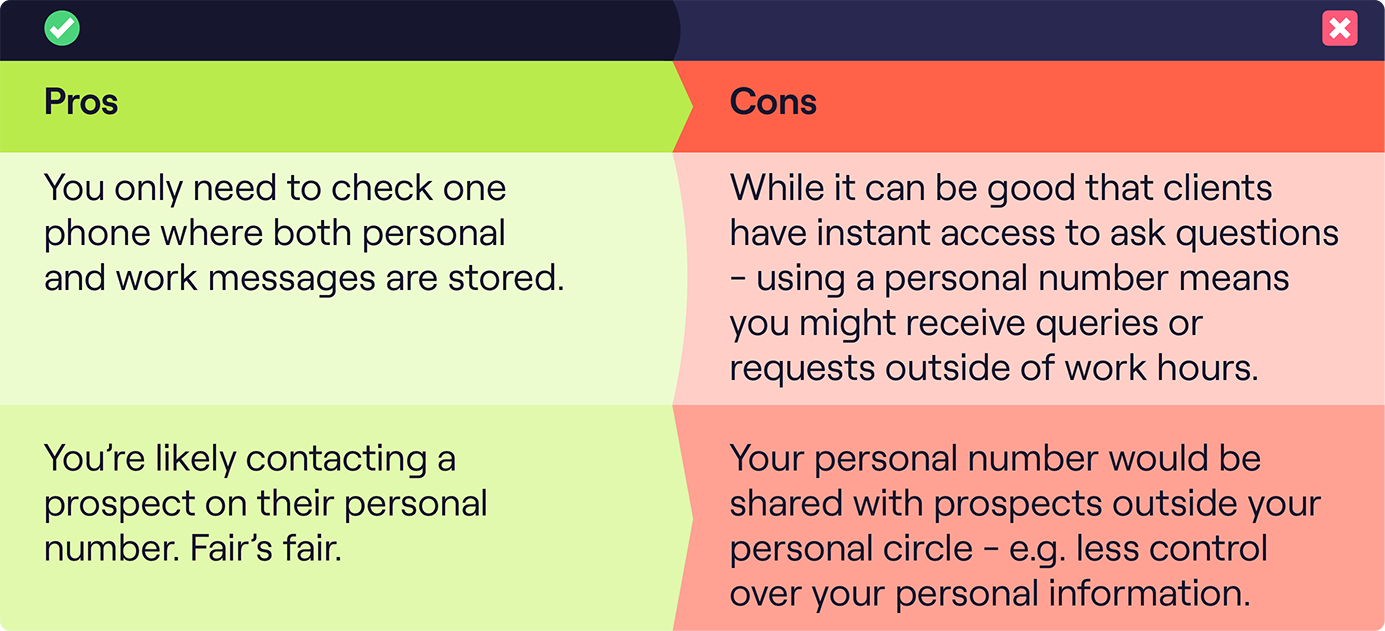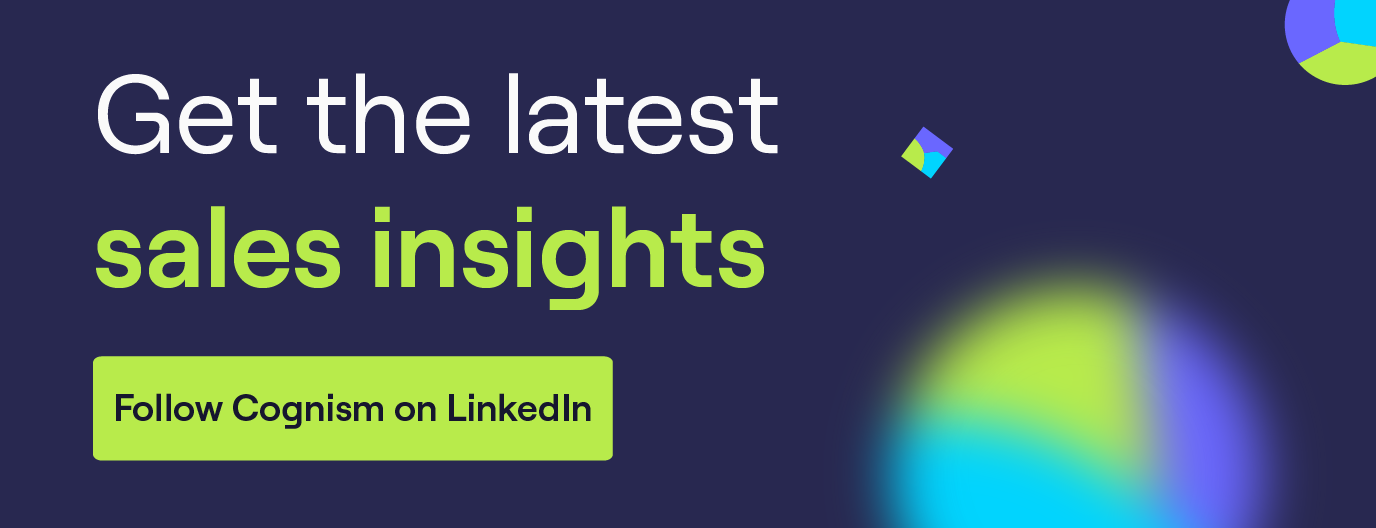WhatsApp for Sales: The Next Outbound Channel?
When you think of WhatsApp, what do you think of?
The first thing that comes to mind is that it isn’t a place to discuss business. It’s for friends and family, isn’t it?
Well, that’s starting to change.
WhatsApp has been repositioning itself as a place for business conversations. And with that has come a wave of early adopters using WhatsApp for sales.
So, could WhatsApp be the next big place to reach your prospects? We spoke to David Bentham, former Director of Sales Development at Cognism and Chris Ritson, Sales Development Flexpert, to find out more.
Why WhatsApp for sales?
David and Chris are both testing WhatsApp as a way of reaching out and following up with their prospects. But why? What makes WhatsApp an appealing place for salespeople?
Chris says:
“Salespeople are always ready to try anything that might get them traction and results. And I think prospects are coming around to the idea of being contacted on WhatsApp.”
Chris had wanted to test using SMS in outbound sales a few years ago but came across more resistance.
He says:
“People seem more open to it now.”
“As much as salespeople might be ready, it has to come down to how customers are willing to be contacted.”
“For a while, I’d been using WhatsApp to speak to customers and hadn’t had much pushback. So I thought it was the right time to test it further up the funnel.”
David adds:
“The beauty of WhatsApp is that everyone is already using it. It’s so popular as a place to communicate already.”
“If you can establish yourself on a channel where people speak to their friends - and other people aren’t - then that should work pretty well.”
“It’s all about standing out from the noise. You need to do what other people aren’t doing.”
WhatsApp has several features which help sweeten the deal for salespeople.
For example, it’s direct, instant access to a B2B prospect. Chris says:
“It not only gives you quick access to a potential future customer, but it also gives them instant access to you. They’re essentially getting direct customer support.”
“The way people want to buy has changed. Customers want to self-serve. But salespeople should still guide prospects to resources and answer questions when they have them.”
“WhatsApp is a very fast way to do that - if it’s positioned in the right way to the buyer. It fits into this digital buying experience that people seem to prefer.”
That’s not all; there are some other upsides to using WhatsApp for sales, such as:
- Not many people are doing it yet - you’re going to stand out if you do.
- You can see if they’ve opened and read your message.
- You can send voice notes, images, or documents.
- Plus, WhatsApp prides itself on its end-to-end encryption. So, all communications are secure and confidential.
Best of all, the channel seems to get results.
Chris says:
“I get a lot of responses using WhatsApp for sales”
We’re sure most salespeople would agree that’s a good reason to test the WhatsApp sales machine.
Are there any downsides?
You might think, ‘Hmm, I’m not sure I’d like to get WhatsApp messages about work.’ And that would be a fair opinion.
Not everyone will consider contact via WhatsApp as appropriate for B2B sales. Chris explains:
“Whenever I post on LinkedIn about using WhatsApp in my outbound, I get very polarised responses.”
“Some people say, ‘that sounds forward-thinking, let’s try it,’ and others say, ‘that’s too invasive for me’.”
“But that’s how most people initially felt about cold calling.”
Chris’s point here is a valid one.
When cold calling first started, some people felt awkward about it. It felt invasive and unusual. Now, it’s a widely accepted part of the business day.
Selling on WhatsApp will likely go through this same adoption process, where early adopters lead the charge in changing opinions on the channel. They benefit from standing out from the crowd, they get results, and then others follow.
Chris adds:
“WhatsApp sales is only going to gather speed for business from here on out.”
One downside is that there isn’t currently a way to trace WhatsApp-related metrics. This is the flip side of a benefit we’ve already mentioned—WhatsApp’s end-to-end encryption.
Security is great, of course. But it will mean, for now, salespeople can’t track response rates or other data.
David says:
“Unless we were to manually keep a spreadsheet of who we spoke to and who replied, we can’t have an easy overview of any metrics for the WhatsApp sales funnel.”
“You have to rely on the feedback from your SDR team - what’s the general feeling? Is it working or not? Are we getting replies?”
How to use WhatsApp in your outbound
There are so many different potential journeys through outbound. But Chris suggests some ways in which you can use WhatsApp for sales with some message templates.
Chris says:
“I tend to be very soft with any calls to action at the end of WhatsApp messages.”
“I usually structure my messages like this:
- Introduction - who I am and the company I represent.
- Problem - the problem I can help to solve.
- Soft CTA - this could be any number of actions. But usually something like, ‘Would you like me to send you more information?’
“And I try to figure out how people feel about receiving messages on WhatsApp. If I get feedback that they don’t like it, then I tread more carefully.”
Chris adds:
“Usually, WhatsApp isn’t the only channel I use.”
“I’d use it to compound my outbound calls. I might have called them and said before ending the call:
‘Shall we take this to WhatsApp? If you need me, you can send me a quick message there.’
That opens up that channel for the future.”
Sometimes, Chris will also use WhatsApp to send a cold outreach message. Other times, he will send a proposal via email and use WhatsApp to let them know he sent it.
He says:
“WhatsApp isn’t the place to send proposals. But it’s great to get a quick response to get eyes on a proposal.”
David agrees that WhatsApp is a place for short, to-the-point messages:
“WhatsApp is perceived as a casual channel, even as it transitions into a place for business conversations. I think you should treat it as a casual place.”
“I wouldn’t send a massive long pitch. In fact, I’d call them first, and depending on whether they answered, I’d send them a message to follow up or say:

How should you present yourself on WhatsApp?
You might have some ground rules in place for interacting on WhatsApp already. Depending on who you are or who you work for.
If not, here are some words of advice from Chris and David.
1. Don’t be afraid to show some personality
Yes, keep things professional. But don’t be afraid of showing a more relaxed side.
You don’t need to be formal in your language, nor do you need to have a LinkedIn-style profile photo.
In fact, it might help your cause to be more informal. Why?
Because you’re breaking the salesperson stereotype that your prospects might be expecting.
For those who’ve yet to use WhatsApp for business, coming across as a more casual acquaintance could be less abrasive. Especially on a channel that’s mostly used to speak to friends and family.
2. Stick to messaging people within business hours
Or more specifically, David says:
“Make sure you’re doing outreach when you’d expect your prospect to be working.”
This might mean it’s a little flexible from the usual office 9 to 5. But the idea is that you speak to your prospects while they’re thinking about work.
You’re less likely to get an aggravated reply in this case. No one wants to be disturbed during their evenings or weekends!
People probably expect to come back after the weekend to emails. But they’re less used to receiving texts or WhatsApps on their personal phones outside of working hours.
However, if you contact a prospect during work hours and they reply to you out of work hours, you can answer at your discretion. Let them set the standards.
3. Keep your messages short and sweet
The same rules apply to WhatsApp sales as they do to texting. No long paragraphs of unbroken text. Instead, Chris says:
“I keep my messages to about two or three sentences, ideally less.”
“I don’t shorten or abbreviate words, and I spell things correctly. But I keep things pretty casual. I write as I would usually text.”
“Quick, shorthand, direct messages. One line of value or one single action they can take.”
Another great option is to use the voice note feature. David mentions receiving a voice note on WhatsApp from someone prospecting him. He says:
“I replayed the voice note to my team afterwards because it was the first time I’d ever received a message like that from another salesperson. It stood out, so, of course, I remember it and talk about it.”
4. Use a work phone
This might not always be possible. Not all businesses can hand out business phones to all SDRs just to use WhatsApp.
However, David says:
“Ideally, you’d have a work phone. I have a work phone with WhatsApp downloaded.”
There are some pros and cons to using your personal phone number for outbound, such as:

It really comes down to what you’re comfortable with as a salesperson regularly dealing with prospects. (Everyone should be entitled to put their phone away and not think about work every once in a while!)
WhatsApp for sales: The final word
Chris says:
“People are more open to WhatsApp selling than they have ever been before.”
So, it makes sense for salespeople to seize the opportunity before it becomes another overcrowded channel.
Why not test if WhatsApp can work as an outbound channel for you? You may reap the rewards of being an early adopter.

/Cold%20calling%20strategy/cold-calling-strategy-card.webp)

